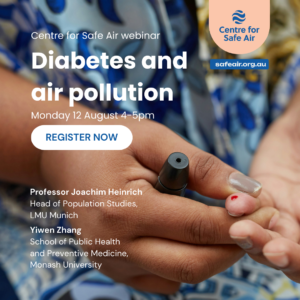Webinar

September 2024. The transport sector contributes nearly a fifth of Australia’s air pollution. Creating safer air for all Australians means thinking about transport fuels and their emissions, who is most at risk, and the types of settings where people are exposed to transport-related air pollution.
In this webinar we heard from Dr Timothy Chaston, a research fellow at the University of Sydney, and Affiliate at the Centre for Safe Air. He was joined by Keith Loveridge, former Senior Sustainability Officer with the City of Maribyrnong and lecturer and tutor at RMIT, who has made a significant impact as a citizen scientist and advocate for reducing transport emissions in Melbourne.
The webinar and a live Q&A was facilitated by Geoffrey Morgan, Associate Professor at the University of Sydney and Chief Investigator at the Centre for Safe Air.

Children are especially vulnerable to air pollution which can have both acute and long-term impacts on their health and wellbeing.
Allergies, asthma and the airborne transmission of infectious diseases are the most visible impacts of air pollution for children under 15 years of age. However, beginning in the womb, children can be exposed to air pollution that impacts their long-term respiratory, cardiovascular, and cognitive health in ways that are less obvious.
Improving air quality in the settings where children spend much of their time—such as schools, playgrounds and in the home—represents an important opportunity for improving health outcomes for Australians across the life course.
In this webinar, we hear from air quality researchers and public health professionals with a particular focus on improving children’s health: Dr Amanda Wheeler, Senior Research Scientist CSIRO, and Associate Investigator at the Centre for Safe Air; Hayley Dyke, Medical Lead for Communicable Disease Surveillance and Response, Centre of Disease Control, NT Health
The webinar and Q&A will be moderated by Dr Sabrina Idrose, Postdoctoral Research Fellow at the Centre for Safe Air and Research Fellow at the University of Melbourne.
Access the YouTube recording here: https://www.youtube.com/watch?v=XJtKUaH4MpE&t=45s

Improving indoor air quality is one of the best ways to improve public health and reduce the health burden associated with infectious diseases, asthma, and a range of other health conditions.
While we spend nearly 90% of our time indoors, indoor air quality is largely unregulated and is subject to pollution from a range of indoor and outdoor sources.
In this Centre for Safe Air webinar, we heard from a leading expert in indoor air quality, Distinguished Professor Lidia Morawska (QUT), and Policy Manager at Asthma Australia, Angela Cartwright. The webinar and Q&A was facilitated by Centre for Safe Air Postdoctoral Researcher, Dr Nicolás Borchers Arriagada.
The webinar explored indoor air quality as it relates to public buildings (including the science behind the push for national indoor air quality standards) and in the home (in relation to asthma triggers, policy developments and recommendations).
Join the Centre for Safe Air mailing list to receive invitations to future webinars: www.safeair.org.au/connect
Access the YouTube recording here: https://www.youtube.com/watch?v=gp5NKvJrCIE&t=3s

1.5 million Australians – almost five per cent of the population – live with diabetes.
While links with obesity and diet are well known, air pollution is also a significant modifiable risk factor. In 2021, nearly 10% of diabetes related deaths in Australia were attributed to air pollution.
In this webinar researchers presented findings regarding the links between diabetes and air pollution, and what this tells us about how to reduce diabetes in Australia: Professor Joachim Heinrich, Head of Population Studies at Ludwig Maximilian University of Munich; and Yiwen Zhang, PhD candidate and member of the Climate, Air Quality Research in the School of Public Health and Preventive Medicine at Monash University.
The webinar and a live Q&A was facilitated by Dr Sabrina Idrose, Post-doctoral Research Fellow at the Centre for Safe Air, Melbourne University.
Access the YouTube recording here: https://www.youtube.com/watch?v=tX26t3YnWkg

Wood heater smoke is the major source of particulate air pollution (PM2.5) in most Australian capital cities and many regional areas, often exceeding pollution from industry and traffic.
In this webinar Centre for Safe Air postdoctoral research fellow, Dr. Nicolás Borchers Arriagada, presented new research findings regarding the health impacts of wood heater pollution across Australia and the benefits of replacing wood heaters with cleaner heating technologies.
He was joined by Kate Garvey, a senior policy maker with the Tasmanian Department of Health and a health consumer whose respiratory condition is impacted by winter wood smoke.
The discussion and a Q&A was facilitated by Dr Sabrina Idrose, Centre for Safe Air postdoctoral research fellow and webinar coordinator.
Access the YouTube recording here: https://www.youtube.com/watch?v=OUjy1u4HrEU&ab_channel=CentreforSafeAir

The risks posed by bushfires and air quality are both predicted to worsen as a consequence of a rapidly warming climate. In this webinar, we heard from leading experts regarding hazard reduction strategies that balance bushfire, smoke pollution and health risks.
This webinar featured leading experts including:
Owen Price, Associate Professor at the University of Wollongong, Centre for Safe Air Chief Investigator, and Director of the Centre for Environmental Risk Management of Bushfires and the Bushfire Risk Management Research Hub
Laurence McCoy, Superintendent and Manager of Predictive Services, NSW Rural Fire Service
Merched Azzi, Atmospheric Research Scientist at the NSW Department of Climate Change, Energy, the Environment and Water
The discussion and a Q&A was facilitated by Dr Sabrina Idrose, Centre for Safe Air postdoctoral research fellow and webinar coordinator.
Join our newsletter
The Centre for Safe Air publishes a monthly newsletter reporting news events, funding opportunities, resources, publications and more. Subscribe to our mailing list to stay up to date.